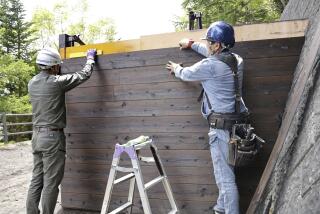Getting Downhill Started Is Still an Uphill Struggle
- Share via
NAGANO, Japan — For five years, they squabbled and haggled, threatened and counter-threatened, risked international incident and finally settled on a compromise that ensured the Hakuba men’s downhill ski run would be environmentally correct.
Then, with the world’s finest skiers finally bibbed up and queued up and ready to thrash the slope, the environment decided to weigh in.
White Ring is the name of the figure skating arena here; White Out was the story line to the blue-ribbon event in Olympic Alpine skiing Sunday.
The Hermannator against Tommy Moe and the rest of the ski world, called on account of snow.
It had to figure, given Mount Karamatsu’s stubborn history. For five years, the men’s downhill had been one royal pain in the Nagano Olympic program, producing nothing but angst and bad publicity for organizers as environmentalists and International Ski Federation (FIS) officials feuded over where, exactly, on the mountain to start the race.
All of a sudden, the mountain was going to turn nice and compliant, just because CBS’s cameras were watching?
The dispute revolved around an insect as light as a feather, the endangered Gifu butterfly. The Gifu makes its home in a national park on the top of Karamatsu, a park that became the battleground in the downhill war.
FIS officials wanted the course to be World Cup caliber in length and proposed the starting gate be situated at 1,800 meters, which would produce runs of about two minutes, the average on the World Cup circuit.
But to begin the course at 1,800 meters meant planting the starting gate within the boundaries of the national park. Environmentalists balked and Makoto Kobayashi, director-general of the Nagano Organizing Committee, was quick to align himself with the cause.
Kobayashi proposed placing the starting gate beneath the park, at 1,680 meters, which would slice 15 to 30 seconds off the time of the average run.
Unsatisfactory, countered FIS president Marc Hodler, and the verbal bayonets were fastened.
For five years, Kobayashi and Hodler went back and forth on that slope, inching the start a little higher, then a little higher after that, arm-wrestling over mere feet.
Along the way, Kobayashi threatened to resign and Hodler threatened to pull all Alpine ski events out of Nagano, which would have marked the first official Olympic boycott by a sports federation.
Hodler also, at the peak of exasperation, publicly likened Kobayashi’s dictatorial ways to Fidel Castro’s, remarks that infuriated the Japanese and forced Hodler to issue a public apology.
Finally, in December, the impasse was interrupted by a brainstorm:
Instead of starting the race inside the park or below the park, why not start it outside the park--wrapping the first leg of the course along the outer right rim of the park?
That stretched the length of the run to 1,765 meters, not quite up to Hodler’s desired “world-class standards,” but long enough for both sides to declare an armistice.
Hodler was less than pleased, but Kobayashi sounded triumphant.
“Environmental things are of interest to us,” Kobayashi said. “The starting point has become a symbol of our regard. If we were to raise it, we’d be called the Nagano Olympics that destroyed the environment.”
As for the men who would actually have to ski down the thing, there have been complaints.
After reeling off a few practice runs, Austrian wunderbolt Hermann “the Hermannator” Maier groused that the run was too flat. French contender Jean Luc-Cretier griped that “the snow is not that fast. For an Olympic course, it’s a bit easy.”
Easy, maybe, when you can see at least to the tips of your skis. But Sunday, the view from the starting gate most closely resembled a black and white television screen with a broken antenna--not much beyond white noise.
So the skiers sit and wait . . . and possibly sit and wait some more. According to finish referee Matjaz Kranjc, more snow--accompanied by high winds--is forecast for Monday.
“It is a pity to cancel the race,” Kranjc said, “but it is the Olympics, and the racers should have the best race possible. We will try again.”
The curse of Karamatsu continues.
More to Read
Go beyond the scoreboard
Get the latest on L.A.'s teams in the daily Sports Report newsletter.
You may occasionally receive promotional content from the Los Angeles Times.






